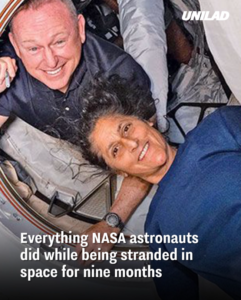NASA astronauts Barry “Butch” Wilmore and Sunita “Suni” Williams embarked on a mission aboard Boeing’s Starliner capsule on June 5, 2024, originally intended to last just eight days. However, due to thruster malfunctions detected upon docking with the International Space Station (ISS), their return was postponed, resulting in an unplanned extension of over nine months in space.
Daily Life and Routine Maintenance
Life aboard the ISS requires adherence to a structured daily routine to maintain both physical health and the station’s functionality. Wilmore and Williams engaged in regular exercise sessions using specialized equipment to counteract muscle atrophy and bone density loss associated with prolonged weightlessness. They also performed routine maintenance tasks, ensuring that all systems operated optimally. This included inspecting and repairing equipment, monitoring life support systems, and managing supplies essential for the crew’s sustenance.
Scientific Research and Experiments
A significant portion of their extended mission was dedicated to scientific research. During their time on the ISS, Wilmore and Williams conducted approximately 150 experiments across various disciplines.
These experiments encompassed studies on human physiology, where they observed how extended exposure to microgravity affects bodily functions. They also conducted experiments in physical sciences, such as fluid dynamics and combustion in microgravity, which have direct applications in improving industrial processes on Earth. Additionally, they participated in technological demonstrations, testing new tools and materials that could be utilized in future space missions.
Extravehicular Activities (EVAs)
Beyond their scheduled tasks, the astronauts also engaged in educational outreach activities. They conducted live sessions with students and the public, sharing insights about life in space and the importance of scientific exploration. These interactions aimed to inspire the next generation of scientists, engineers, and explorers.
Adaptation and Resilience
The unexpected extension of their mission required significant psychological resilience. Both Wilmore and Williams adapted to the prolonged stay by maintaining a positive outlook and focusing on their duties. Their military backgrounds and previous spaceflight experiences equipped them with the discipline and mental fortitude necessary to handle the challenges of an extended mission. They also relied on regular communication with family and friends to stay connected to life on Earth, which is crucial for mental well-being during long-duration space missions.
Return to Earth
After 286 days in space, Wilmore and Williams, along with NASA astronaut Nick Hague and Russian cosmonaut Aleksandr Gorbunov, returned to Earth aboard a SpaceX Crew Dragon capsule. The capsule safely splashed down off the coast of Florida, where the crew was greeted by recovery teams. Notably, a pod of dolphins surrounded the capsule during recovery operations, providing a unique welcome back to Earth.
Upon retrieval, the astronauts underwent standard medical evaluations to assess their health after the prolonged mission. They were then transported to NASA’s Johnson Space Center for further debriefings and reintegration procedures.
Conclusion
The unforeseen extension of Wilmore and Williams’ mission underscores the unpredictable nature of space exploration. Their ability to adapt and continue contributing to scientific knowledge during this period exemplifies the resilience and dedication required of astronauts. The experiments conducted and the data gathered from their prolonged stay provide valuable insights that will inform future long-duration missions, including those aimed at deep space exploration.
